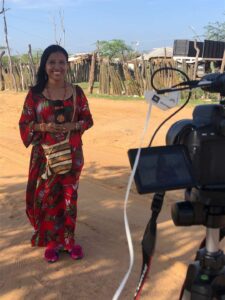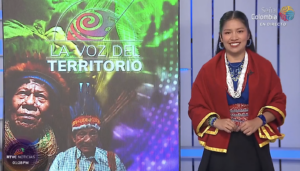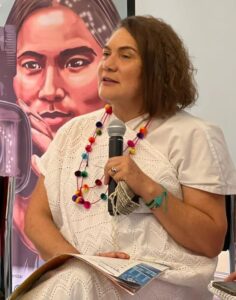When Eduvilia Uriana told her family she wanted to pursue journalism, it was not well received. In the Wayúu indigenous community, in the department of La Guajira in northern Colombia, journalists have a reputation for spreading misinformation, and journalism is considered a profession for “arijunas” – non-indigenous people, in Wayuunaiki.
Uriana recalls her mother was the one who supported her unconditionally. In 2015, she learned about a training project led by the Wayúu People's Communications Network, which offers mobile training for young people in journalism, radio, video, and print production in La Guajira. She graduated as an indigenous community communicator in 2017 and is currently studying communication at the National Open and Distance University.
“To me, journalism means self-love,” Uriana told LatAm Journalism Review (LJR). “Journalism has taught me about self-love, to believe in myself, in Eduvilia's abilities, and also in the potential of many women in the region.”

Eduvilia Uriana es periodista indígena del pueblo Wayúu (Colombia). (Foto: Cortesía RTVC)
Uriana became the first Wayúu journalist to join the National Radio of Colombia, the country’s public radio network. She reports from La Guajira for public radio and television broadcasts.
She and Sandra Chindoy, a reporter for the public broadcaster’s RTVC Noticias and a member of the Kamëntsa indigenous community from Putumayo in southwestern Colombia, are currently the face of indigenous journalism in Colombia's national media.
But in a country where people identifying as indigenous account for almost 4% of the population, their representation and participation in national media remains low. That’s why indigenous communities across the country have been working for more than 30 years to be fairly represented in the media.
Uriana’s path in journalism hasn't been easy, she said. She has faced discrimination from sources and even from her own colleagues, she said. But she doesn’t give up. She is receiving more positive feedback from elders and leaders in her community, and sometimes they even suggest issues for coverage.
“Being a journalist in this region means being exposed to many risks,” Uriana said. “First, because I’m a woman, and because I’m indigenous. But it’s also a blessing because through the national media, the voices, feelings, and thoughts of indigenous peoples can be heard and shown.”
Chindoy, who studied social sciences with a focus on public management, says she sees her arrival in journalism as a major responsibility as the first indigenous woman in a national news program.
“I’m not sure if it’s so much a source of pride as it is a reason to reflect,” she told LJR. “Television in Colombia just turned 70. And how is it that after 70 years, we’re only now realizing that there are indigenous people here, in a country that is on indigenous land?”
She says she feels it’s her responsibility to open doors for other indigenous communicators so at least public media outlets reflect the diversity of Colombia. From her segment, La Voz del Territorio, or The Voice of the Land in English, Chindoy also focuses on changing what she says is the harmful way traditional media have covered indigenous peoples: based on violence and discrimination.

Sandra Chindoy, del pueblo indígena Kamëntsa de Colombia, es presentado de RTVC Noticias, el informativo del sistema de medios públicos del país. (Foto: Captura de pantalla)
The presence of Uriana and Chindoy in national media may open more spaces in journalism for indigenous communicators and better coverage of topics directly related to indigenous peoples. But they are not the only indigenous voices in media.
For over 30 years, indigenous peoples in the department of Cauca in southwestern Colombia have fought for indigenous communication as a right. The Regional Indigenous Council of Cauca (CRIC), founded in 1971 and now composed of 11 community associations, has eight radio stations serving 26 towns across the region. They also have a webcast, a newspaper and videos.
“We see communication as strategic and political,” Dora Muñoz, an indigenous communicator from the Nasa people in Cauca, told LJR. “Through communication, we share our organization’s proposals as peoples, report, and make our activities visible. But we also promote a way of thinking, especially our principle of caring for life and defending the land, which is fundamental for us as indigenous peoples.”
One way to cultivate its own media channels is through the Intercultural Indigenous Communication program offered by the CRIC's Autonomous Indigenous Intercultural University, Muñoz said. The program, which has graduated four cohorts, teaches communication as seen by indigenous peoples.
Indigenous authorities and communicators from across the country first convened in 2012 in the National Commission on Indigenous People’s Communication, or CONCIP for its initials in Spanish. The commission seeks to create and ensure the implementation of a public policy that recognizes communication by and for indigenous peoples as a right.

Silsa Matilde Arias, del pueblo indígena Kankuamo y secretaria técnica de la Comisión Nacional de Comunicación de los Pueblos Indígenas (CONCIP) de Colombia.
The commission also trains indigenous communicators, said Silsa Matilde Arias, technical secretary and a member of the Kankuamo people in the Sierra Nevada de Santa Marta in northern Colombia. It operates 32 non-university communication schools and 35 indigenous radio stations across the country.
According to Arias, these training programs, which date to even before the existence of CONCIP, have helped journalists like Uriana participate in national media. She said she also believes many more indigenous journalists are capable of working not only for National Radio but also other media.
In 2013, with support from the National Indigenous Organization of Colombia, or ONIC for its initials in Spanish, they launched the country’s first indigenous news magazine. “Colombia Nativa” was broadcast on the Canal Capital channel for three seasons.
“We have substantial assets,” Arias said. “We are of service to the community.”
Training indigenous communicators has allowed them to find other ways to tell their stories, both within and outside their communities. One example is the series “El Buen Vivir,” which now has six seasons and aims to portray Colombia’s 115 indigenous peoples. Arias proudly highlights how the latest season was primarily directed and produced by indigenous women.
They have also created films and documentaries that have reached festivals such as Indifest in Barcelona, organized in collaboration with the Latin American Coordinator of Indigenous Peoples' Film and Communication, as well as festivals in New York and Toronto.
“Our challenge today is our distribution plan,” Arias said. “We’re on screen in Toronto, and yet in Colombia people don’t know what we’re doing in film.”
Another indigenous news outlet is Agenda Propia, a digital native platform created to provide “responsible” coverage by valuing the voices of indigenous peoples, founder Edilma Prada told LJR. Prada is not indigenous, but covered the Cauca region for years, and learned about indigenous peoples' long-standing objections to how they were portrayed in the media.
Agenda Propia covers issues related to indigenous peoples in Latin America through intercultural teams and councils — in other words, with indigenous and non-indigenous journalists. They also hold “circles of the word” where indigenous leaders meet with journalists to discuss issues relevant to their land.
For Prada, in addition to participation in the media, the relevance of indigenous journalists reaching media beyond their communities lies in the possibility of telling their own stories with their own style and worldview.
“This is a bit of what we try to do at Agenda Propia,” Prada said. “I don’t know if we’ve achieved it, but we aim for respect for the unique style of the storytellers. Otherwise, there’s no point.”